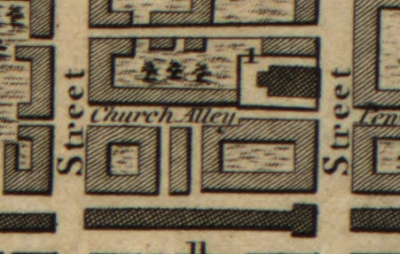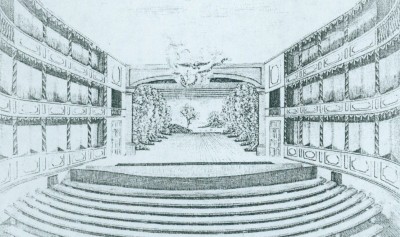Where They Danced: Part I
July 7, 2014
THE LATE EIGHTEENTH CENTURY
These next few posts will explore the urban spaces where Philadelphians danced—where they performed for audiences, taught classes for adults and children and where they hosted their elaborate balls during their winter social seasons. In this post, I’ll talk about two halls, two hotels and two theatres. Clicking on any image will open it larger in a new window.
The map above, from 1795, shows the dark shaded triangle that was the built up part of Philadelphia about 1795. Its broad base stretches along the Delaware Riverfront on the right and its apex barely reaches to 10th Street just north of High (Market) Street, pointing toward the empty Public Square to the west where the tower of City Hall would rise a hundred years later. Click on the map to see a larger version.
The cluster of green dots just below the market stalls of High Street show the concentration of dance spaces in Old City. They are at the heart of a densely populated commercial area, full of inns, banks and shops. The long sets of country dances popular in the eighteenth century required long unobstructed dance floors. In the 1790s, this meant using academic classrooms after school hours, Masonic lodges, taverns, hotels and the large spaces found in public theatres. Only a very few private homes, like that of Samuel and Elizabeth Powel on Third Street south of Walnut, had any kind of space large enough to be called a ballroom.
From 1790 to 1800, Philadelphia was the political and social capital of America. Dance teachers and the schools they established flourished, catering to the elite clientele that competed for places in the capital city’s brilliant social scene.
CHURCH ALLEY
On Church Alley, just west of Christ Church, “1,” above, was Stephen Sicard’s 30 by 40 foot “noted dancing-room.” Sicard had come to Philadelphia from France about 1783, well before the French Revolution. He advertised himself as “a pupil of the celebrated Mr. Vestries, and assistant master of Mr. Gardell, the first dancing master of the Opera at Paris.” His advertisements made it clear that “he would address his pupils in English.” In 1791, he composed a ballet entitled Congress Returns for his young pupils. Sicard was also a musician and composer. He wrote “The President of the United States’ March” to honor George Washington as well as several sets of cotillions for dancing. Sicard taught dance to hundreds of students in Philadelphia for over thirty years, until his retirement in 1815.
The large room Sicard taught in was also used for lectures, a fencing school, and a concert series. It was owned by Peter le Barbier Duplessis, another Frenchman who came to Philadelphia after the War of Independence. Duplessis was a notary public as well as a certified translator. He was also a Freemason and rented or loaned his room for masonic lodge meetings. Although a French Catholic, Duplessis became involved with St. Paul’s Episcopal Church, on Pine Street, where he is buried.
HARMONY HALL
The little cobblestone and brick brick path that now runs from 4th to 3rd Street just behind the Todd House and the Bishop White House on Walnut Street was once an alley called Harmony Court, above. All the buildings on Harmony Court were razed in the 1950s for the landscaping of what is now Independence Park.
The building there, marked in red on the map above, was called Harmony Hall. The dancing hall was on the second floor above a livery stable. Like its counterpart in Church Alley, it hosted meetings, lectures and performances as well as dance classes. At the end of the eighteenth century, several dance masters taught there, including William McDougal, Balthazar Quesnet, Mr. Francis and his good friend, the first American born professional dancer, John Durang.
 Harmony Hall and the livery stable were owned by an interesting Philadelphian named Israel Israel, right. Despite his name, he was only half Jewish and married a Quaker wife, Hanna Erwin. He ran the Cross Keys Tavern at Third and Chestnut Streets, rented out stables, owned several buildings and served as the High Sheriff of Philadelphia County. He was also Grand Master of the Grand Lodge for many years, so as with the long room on Church Alley, Harmony Hall was also used for lodge meetings. The Israels now rest in the beautiful Laurel Hill Cemetery.
Harmony Hall and the livery stable were owned by an interesting Philadelphian named Israel Israel, right. Despite his name, he was only half Jewish and married a Quaker wife, Hanna Erwin. He ran the Cross Keys Tavern at Third and Chestnut Streets, rented out stables, owned several buildings and served as the High Sheriff of Philadelphia County. He was also Grand Master of the Grand Lodge for many years, so as with the long room on Church Alley, Harmony Hall was also used for lodge meetings. The Israels now rest in the beautiful Laurel Hill Cemetery.
TWO HOTELS
 In the early 1790s, the Philadelphia Dancing Assembly held their dancing season at Old City Tavern, seen next to the Bank of Pennsylvania, left on 2nd Street near Walnut Street for many years. When Oellers’ Hotel opened on Chestnut near 6th they moved there. I’ve talked a bit about Oellers’ Hotel in another blog post here. Among the Philadelphia dancers who taught at Oellers’ were Gaspard Cenas, Mr. Lancon and James Robardet, who instructed George and Martha Washington’s two grandchildren, Nelly and George Washington Custis in the art of dancing. In 1792, George wrote a letter of recommendation for Robardet:
In the early 1790s, the Philadelphia Dancing Assembly held their dancing season at Old City Tavern, seen next to the Bank of Pennsylvania, left on 2nd Street near Walnut Street for many years. When Oellers’ Hotel opened on Chestnut near 6th they moved there. I’ve talked a bit about Oellers’ Hotel in another blog post here. Among the Philadelphia dancers who taught at Oellers’ were Gaspard Cenas, Mr. Lancon and James Robardet, who instructed George and Martha Washington’s two grandchildren, Nelly and George Washington Custis in the art of dancing. In 1792, George wrote a letter of recommendation for Robardet:
Dear Sister & Dear Madam,
Mr James Robardet, who has taught my two Grand children dancing, proposes going into your part of the Country to establish a School, if he should meet with sufficient encouragement, and has requested that I would give him a line of recommendation to some of my friends. Mr Robardet’s attention to my grand children, and the progress which they have made under his instruction, induce me to recommend him on these accounts from my own knowledge: He has likewise kept a dancing School in this City the winter past—in which I am informed he has given much satisfaction, and his conduct has been marked with decency & propriety, so far as I have heard.
TWO THEATRES
Many of the dance teachers who came to Philadelphia were professional performers who taught classes to supplement their incomes. The two most important theatres in Philadelphia at the end of the 18th century were the Southwark, or “Old” Theatre, on the south side of Cedar or South Street near 4th, and the Chestnut Street, or “New” Theatre on the north side of Chestnut near 6th Street. I’ve already given a detailed account of the Southwark Theatre here, and described how the Chestnut Theatre eclipsed it in 1794. A view of the interior of the original Chestnut Theatre, above, shows the rows of plain benches in the pit and the elegant tiers of boxes on either side.
* * *
The Chestnut Theatre and Oellers’, both just west of 6th Street mark the gradual shift of the city’s commercial center west that would begin in the second half of the 18th century and culminate in the construction of a new City Hall at Market and Broad Streets at the end of the 19th century.
Posted in • 18th Century | Leave a Comment »
Tags: balls, Balthazar Quesnet, Chestnut Street Theatre, Church Alley, cotillions, Dance Teachers, dancing rooms, Gaspard Cenas, George Washington, Harmony Court, Harmony Hall, hotels, Israel Israel, James Robardet, John Durang, Mr. Francis, Mr. Lancon, Oeller's Hotel, Old City Tavern, Peter le Barbier Duplessis, Philadelphia Dancing Assembly, Southwark Theatre, Stephen Sicard, The President of the United States' March, theatres, WilliamMcDougal





